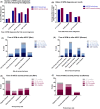Malignancies diagnosed before and after anal squamous cell carcinomas: A SEER registry analysis
- PMID: 33960690
- PMCID: PMC8178496
- DOI: 10.1002/cam4.3909
Malignancies diagnosed before and after anal squamous cell carcinomas: A SEER registry analysis
Abstract
Background: Increased risk of a second primary malignancy (SPM) before or after diagnosis of anal squamous cell carcinoma (ASCC) has been reported in a previous single-institution study. We hypothesize that patients diagnosed with ASCC are at increased risk for developing SPMs before or after the diagnosis of ASCC. The primary objective of this study was to identify the diagnoses of cancer most likely to occur as SPMs before or after ASCC.
Methods: This work employs the Surveillance, Epidemiology, and End Results (SEER) Program registry data to conduct a US-population-based study of patients diagnosed with ASCC between 1975 and 2016. In patients diagnosed with ASCC, we evaluated the risk of SPMs and the risk of developing ASCC as an SPM after another cancer using standardized incidence ratios (SIR) for all SPMs by calculating the ratio of observed events in the ASCC cohort compared to expected (O/E) events in a matched reference cohort of the general population.
Results: A total of 7,594 patients with primary ASCC were included. Patients with ASCC were at increased risk of the diagnosis of an SPM (SIR = 1.45), particularly cancers of the lung, vulva, oropharynx, or colon. Patients with ASCC had an increased rate of previous malignancy (SIR = 1.23), especially Kaposi sarcoma or vulvar cancer. Overall elevated incidence of SPMs was unrelated to prior radiation treatment. Radiation treatment was associated with increased risk for SPMs in the female genital system but appeared protective against prostate cancer as SPMs.
Conclusions: Our findings support increased surveillance and screening for second malignancies in patients with these diagnoses, as patients with ASCC are often either survivors of a prior cancer diagnosis or are at increased risk of developing later malignancies.
Keywords: SEER program; anus neoplasms; neoplasms; second primary.
© 2021 The Authors. Cancer Medicine published by John Wiley & Sons Ltd.
Conflict of interest statement
The authors of this study indicate no potential conflict of interest. Author disclosures are as follows: Dr. Jabbour receives grant funding from and is a research consultant for Merck, and a consultant for Syntactx. Dr. Romesser receives research support from and is a consultant for EMD Serono and is a board member of the HPV Alliance and Anal Cancer Foundation. Dr. Wu receives research grants from CivaTech Oncology, Inc., personal fees from AstraZeneca, and is on the advisory board of Simphotek, Inc. Dr. Jethwa receives honoraria from Radoncquestions.com, LLC.
Figures

Similar articles
-
Risk of second primary malignancies following cutaneous melanoma diagnosis: a population-based study.J Am Acad Dermatol. 2010 May;62(5):757-67. doi: 10.1016/j.jaad.2009.07.039. Epub 2010 Mar 12. J Am Acad Dermatol. 2010. PMID: 20223559
-
Second primary anal and oropharyngeal cancers in cervical cancer survivors.Am J Obstet Gynecol. 2019 Nov;221(5):478.e1-478.e6. doi: 10.1016/j.ajog.2019.05.025. Epub 2019 May 22. Am J Obstet Gynecol. 2019. PMID: 31128108
-
Elevated risk of human papillomavirus-related second cancers in survivors of anal canal cancer.Cancer. 2017 Oct 15;123(20):4013-4021. doi: 10.1002/cncr.30828. Epub 2017 Jun 13. Cancer. 2017. PMID: 28608917
-
Vulvar High-Grade Squamous Intraepithelial Lesions and Cancer as a Risk Factor for Anal Cancer: A Review.J Low Genit Tract Dis. 2022 Jan 1;26(1):32-37. doi: 10.1097/LGT.0000000000000631. J Low Genit Tract Dis. 2022. PMID: 34670242 Review.
-
Unraveling Emerging Anal Cancer Clinical Biomarkers from Current Immuno-Oncogenomics Advances.Mol Diagn Ther. 2024 Mar;28(2):201-214. doi: 10.1007/s40291-023-00692-9. Epub 2024 Jan 24. Mol Diagn Ther. 2024. PMID: 38267771 Free PMC article. Review.
Cited by
-
Executive Summary of the Lower Anogenital Tract Cancer Evidence Review Conference.Obstet Gynecol. 2023 Sep 1;142(3):708-724. doi: 10.1097/AOG.0000000000005283. Epub 2023 Aug 3. Obstet Gynecol. 2023. PMID: 37543740 Free PMC article.
References
-
- American Cancer Society . Cancer Treatment and Survivorship Facts and Figures 2019‐2021. 2019:1‐48. https://www.cancer.org/research/cancer‐facts‐statistics/survivor‐facts‐f....
MeSH terms
Grants and funding
LinkOut - more resources
Full Text Sources
Other Literature Sources
Medical

